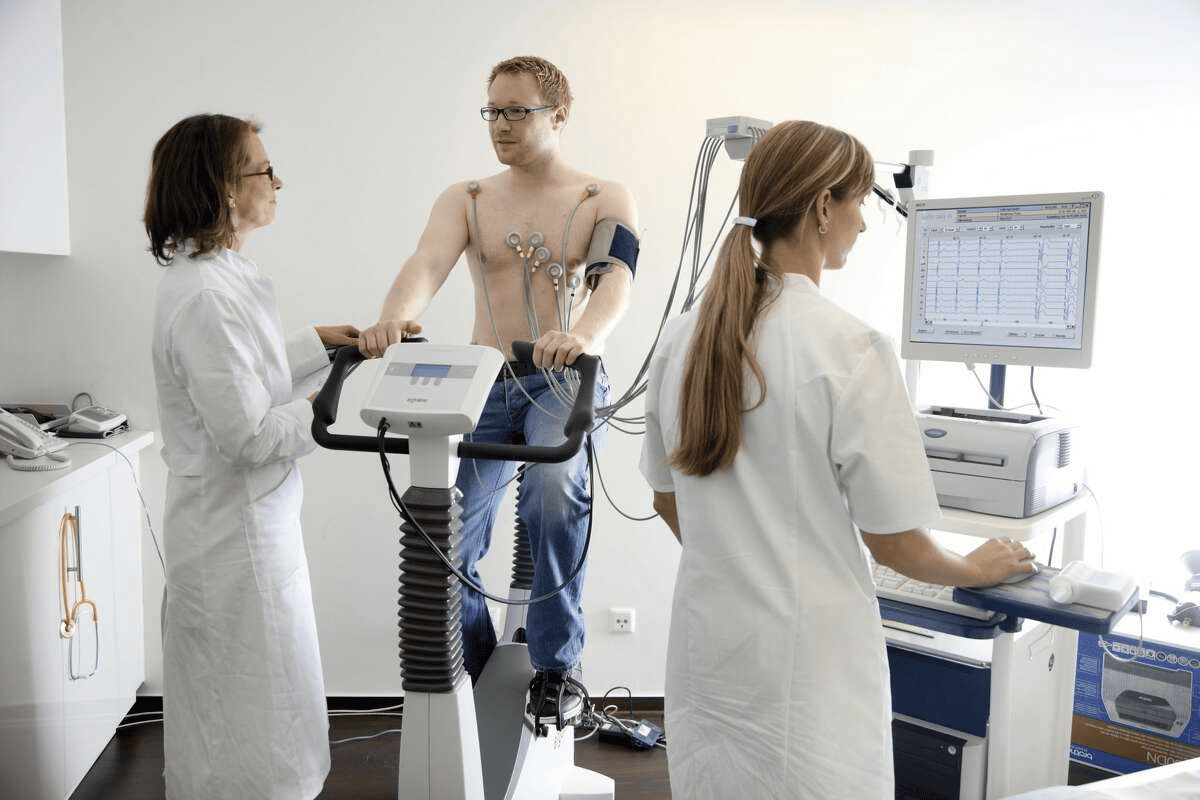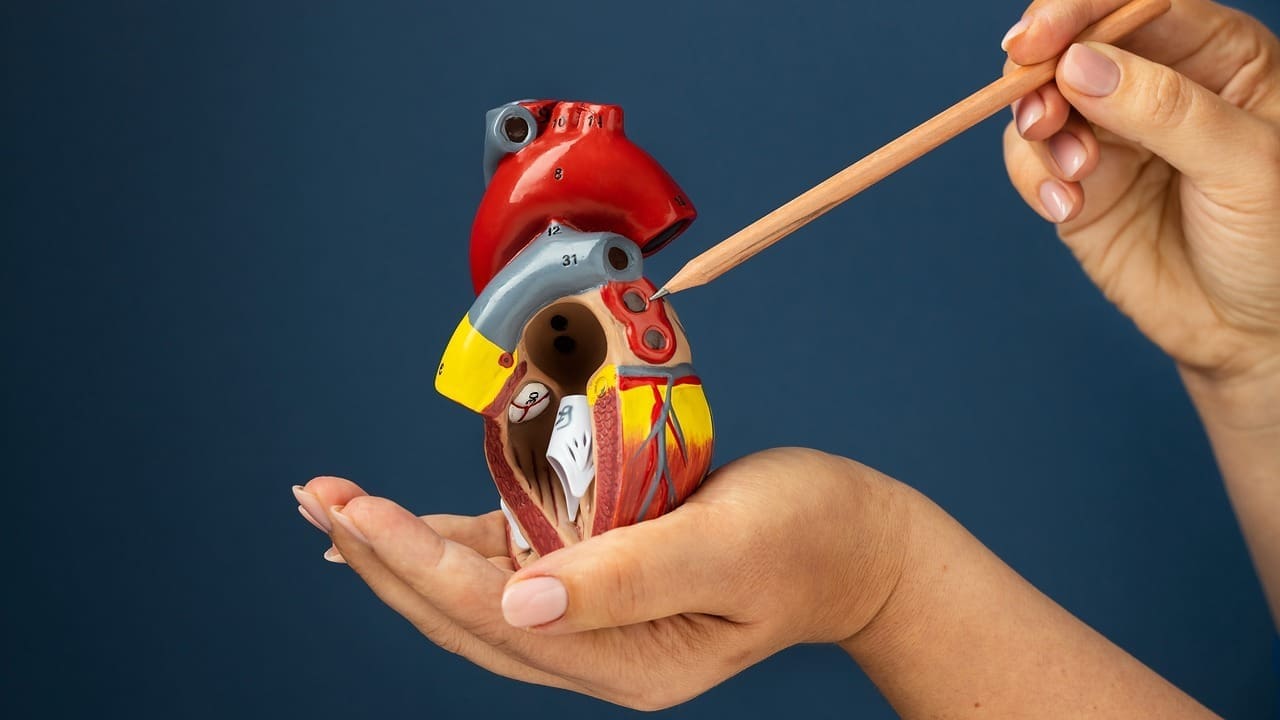Last Updated on November 27, 2025 by Bilal Hasdemir
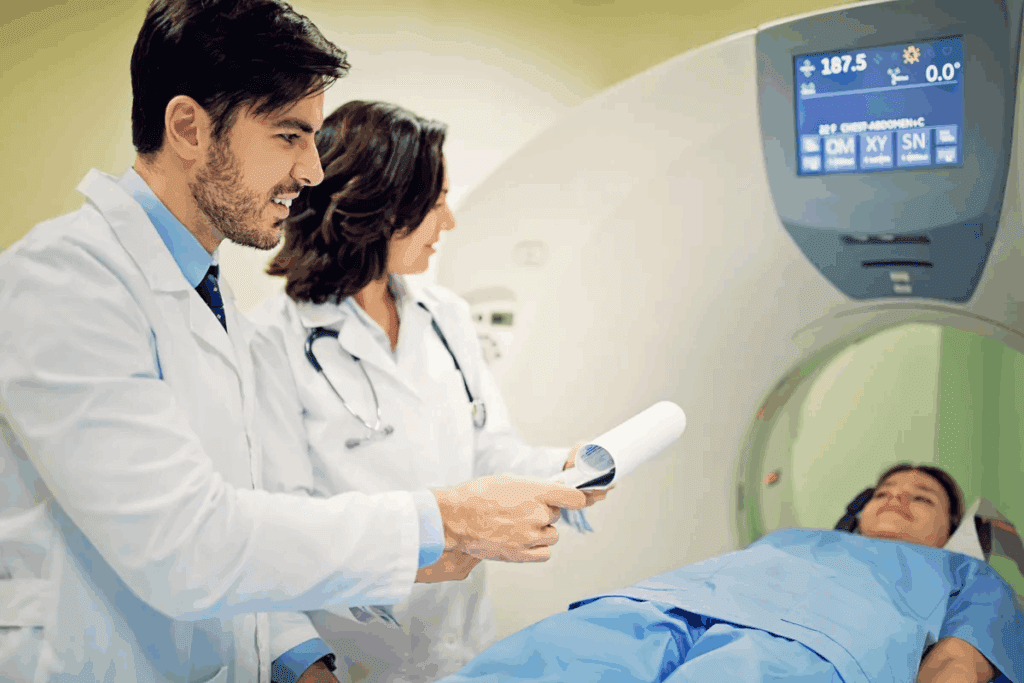
Nearly 2 million PET scans are done every year in the United States. A big part of these use Fluorodeoxyglucose (FDG) as the tracer. FDG PET scans have changed how we diagnose diseases, giving us deep insights into the body’s metabolism.
These scans are key for finding and treating many health issues. This includes cancer, brain disorders, and heart diseases. Even though they are mostly safe, FDG PET scans can cause side effects. These can be mild or serious.
Key Takeaways
- FDG PET scans are a vital diagnostic tool in modern medicine.
- Nearly 2 million PET scans are performed each year in the U.S.
- FDG is a commonly used radiotracer in PET scans.
- Potential side effects of FDG PET scans can vary in severity.
- Understanding these side effects is key for patient safety.
What is Fluorodeoxyglucose (FDG)?
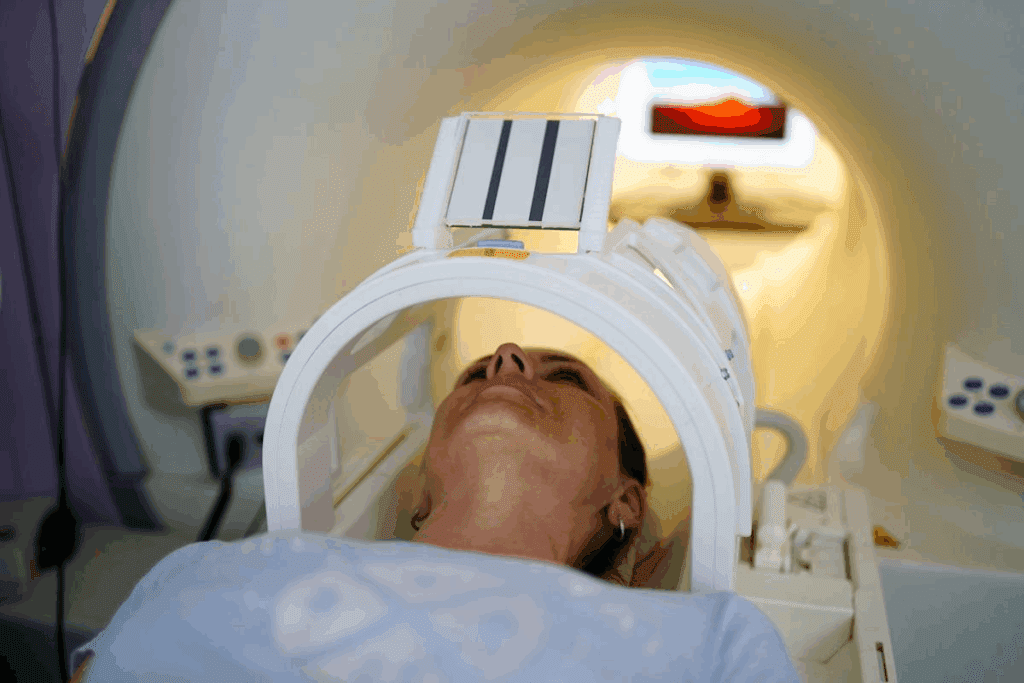
Fluorodeoxyglucose (FDG) is one of the most widely used radiotracers in PET scans. It helps show how the body uses energy. FDG is a special glucose molecule that PET scans can detect.
Chemical Structure and Properties
FDG looks like glucose but has a fluorine-18 atom instead of a hydroxyl group. This change makes it radioactive. It’s taken up by cells like glucose but can’t be broken down further.
How FDG Mimics Glucose in the Body
FDG uses the same ways cells take up glucose. Inside cells, it gets stuck because it can’t be broken down further. This makes it stay in cells.
This trapping helps FDG build up in areas with lots of glucose use, like tumors. It’s a key tool for finding and tracking diseases, mainly in cancer treatment.
Development as a Medical Radiotracer
The creation of FDG as a radiotracer was a big step in nuclear medicine. The use of fluorine-18 made FDG perfect for PET scans. Its development has made PET scans common in medicine.
Today, FDG PET scans are vital for managing many diseases. They show metabolic activity that other scans can’t.
The Science Behind Fluorodeoxyglucose PET Scans
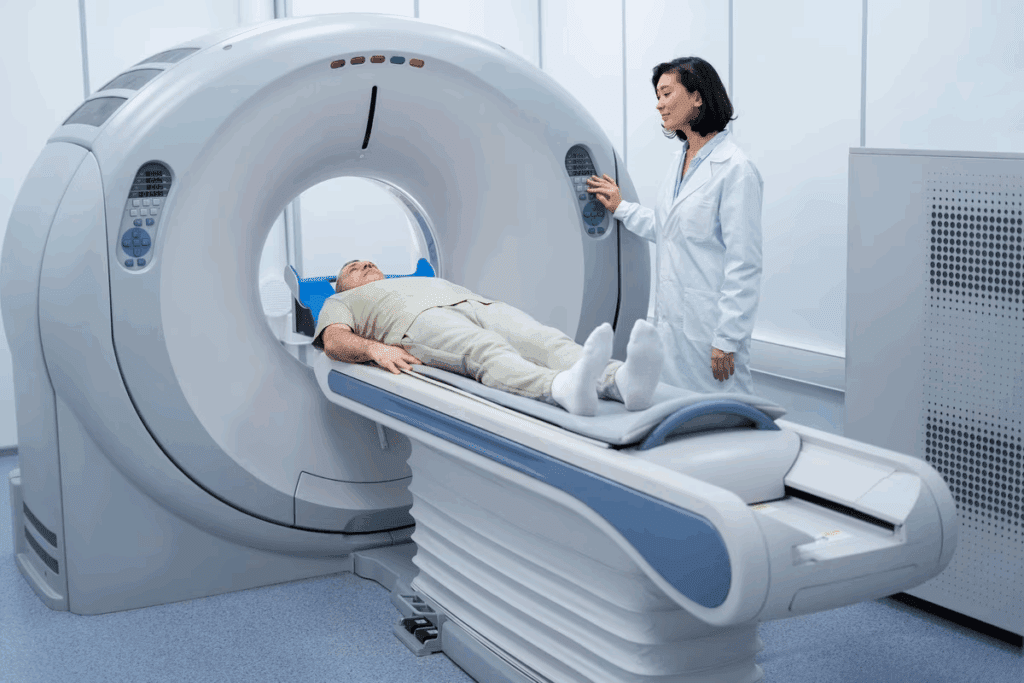
Understanding Fluorodeoxyglucose PET scans is key to seeing their value in medicine. These scans are vital in diagnosing diseases, thanks to their use in oncology, neurology, and cardiology.
Principles of Positron Emission Tomography
Positron Emission Tomography (PET) uses special tracers to show how the body works. It injects a tracer like FDG, which goes to active areas. The tracer’s decay creates gamma rays, making detailed images of the body.
The FDG radiotracer acts like glucose. This lets doctors see where glucose is used more than usual. This is key for spotting tumors or inflammation.
Glucose Metabolism Imaging
FDG PET scans focus on glucose use. Cancer cells use more glucose, so FDG lights them up. This helps doctors find tumors, check treatment, and spot cancer coming back.
These scans also help in neurological applications. They show brain function and find problems like Alzheimer’s or epilepsy. In cardiology, they check heart health and find hidden damage.
Why FDG is the Preferred Radiotracer
FDG is top for PET scans because it’s like glucose. It’s taken up by cells based on their glucose use. Its short half-life means less radiation for patients.
FDG is everywhere in nuclear medicine because it’s easy to use and works well. Research keeps finding new ways to use FDG in medicine.
Common Applications of FDG PET Scans in Clinical Practice
FDG PET scans are very useful in many areas of medicine. They help doctors diagnose and treat different health issues. This includes cancer and neurological problems.
Oncology Applications
In oncology, FDG PET scans are key for cancer diagnosis and staging. They show how far cancer has spread. They also help see if treatment is working and if cancer comes back. A PET scan can tell if a tumor is active, helping doctors decide on treatment.
Neurological Applications
For neurology, FDG PET scans check brain metabolism. They help find neurodegenerative diseases like Alzheimer’s. They show where brain cells are not working right.
Cardiac Imaging
FDG PET scans are used in heart health too. They check if heart muscle is alive and if there’s inflammation. This helps doctors choose the best treatment for heart disease.
Infection and Inflammation Assessment
These scans are also good for finding infections and inflammation. They highlight areas with more glucose, showing where problems are. This helps doctors find and treat infections and inflammation.
| Clinical Application | Description | Benefits |
| Oncology | Cancer diagnosis, staging, and monitoring treatment response | Accurate assessment of cancer spread and treatment efficacy |
| Neurology | Assessment of brain metabolism and neurodegenerative diseases | Aids in early diagnosis and management of neurological conditions |
| Cardiology | Evaluation of myocardial viability and inflammation | Guides treatment decisions for coronary artery disease |
| Infection/Inflammation | Detection and assessment of infections and inflammatory processes | Helps in identifying sites of infection or inflammation |
Different Forms of FDG Used in Medical Imaging
FDG is used in many ways in medical imaging. Each form is made for different needs. One form is the most used in clinics.
18F-FDG: The Standard Form
18F-FDG, or Fluorine-18 Fluorodeoxyglucose, is the top choice for PET scans. It works well because it acts like glucose in the body. This helps doctors see tissues that take up a lot of glucose, like some tumors.
“The use of 18F-FDG has changed oncology a lot,” say doctors. It helps them find and track cancer better.
F-18 Fluorodeoxyglucose Production Methods
Making F-18 Fluorodeoxyglucose is a detailed process. It needs careful steps and strict quality checks. It starts with making F-18, a special fluorine isotope. Then, it’s added to FDG in special labs.
a nuclear medicine expert, says, “Making 18F-FDG is very controlled. It’s all about keeping the product safe and working well.”
Quality Control in FDG Manufacturing
Quality control is key when making FDG. It’s radioactive and must be pure and sterile. Makers follow strict rules to make sure it’s safe for patients. They check for purity and sterility.
- Radionuclidic purity checks if it has the right radioactive isotope.
- Radiochemical purity makes sure the isotope is in the right place in FDG.
- Sterility tests show it’s free from germs.
Keeping high standards in making 18F-FDG helps doctors give better care. It’s a key tool for accurate diagnosis.
The Complete Fluorodeoxyglucose PET Scan Procedure
The Fluorodeoxyglucose PET scan procedure has several steps. These include getting ready, getting the FDG, and the scan itself. Knowing these steps can make patients feel more at ease and ready for their test.
Patient Preparation Before the Scan
Before a PET scan, patients must follow certain guidelines. This ensures the test results are accurate. These guidelines include:
- Fast for 4-6 hours before the scan.
- Avoid hard exercise for a while before the scan.
- Tell your doctor about any medicines you’re taking.
- Take off any metal items, like jewelry, that could get in the way.
FDG Administration Process
A small amount of radioactive glucose is injected into the patient’s vein. This is done through an arm vein. The dose is based on the patient’s weight and the scan’s needs.
Key aspects of FDG administration include:
- The injection is done in a quiet, comfy place to reduce stress.
- Patients are watched for any bad reactions during and after the injection.
- The tracer spreads through the body for about 60 minutes.
The Scanning Process
The patient lies on a table that moves into a PET scanner. The scanner picks up the radiation from the FDG. It makes detailed images of the body’s metabolic activity.
Important considerations during the scan include:
- Stay very quiet and follow breathing instructions for clear images.
- The scan takes 30 to 60 minutes, depending on what’s being scanned.
Post-Scan Protocols
After the scan, patients can usually go back to their normal activities. Unless told not to by their doctor. Drinking lots of water helps get rid of the radioactive tracer.
Post-scan care may include:
- Watch for any late reactions to the FDG.
- Follow up with your healthcare provider to talk about the scan results.
Understanding the Fluorodeoxyglucose PET scan procedure helps patients prepare. It makes the testing process smoother and more accurate.
Common Side Effects of FDG Administration
Fluorodeoxyglucose (FDG) is used in many PET scans. It’s important to know about its side effects for patient care. FDG is mostly safe, but there are common side effects.
Immediate Reactions at Injection Site
Side effects often show up at the injection site. Immediate reactions include:
- Redness or swelling
- Pain or discomfort
- Rarely, infection
These reactions are usually mild and go away on their own. But sometimes, they need medical help.
Systemic Reactions
Some patients also have systemic reactions. These can include:
- Allergic reactions, ranging from mild to severe
- Nausea or vomiting
- Headache or dizziness
These reactions are less common than local ones. But they can be serious and need quick medical help.
Frequency and Severity of Common Side Effects
The side effects of FDG can vary in frequency and severity. Most are mild and short-lived. But sometimes, more serious reactions can happen.
Most patients have few side effects from FDG PET scans. But knowing about allergic reactions and other systemic effects is key for safe use.
Key Points to Remember:
- Most side effects are mild and temporary.
- Serious reactions, while rare, can occur.
- Patient education and monitoring are critical.
Rare but Serious Side Effects of Fluorodeoxyglucose
Though rare, serious side effects can happen with FDG. These include allergic reactions and metabolic issues. It’s important for patients to know about these risks to get help quickly if needed.
Allergic Reactions to FDG
Allergic reactions to FDG are rare but can be serious. Symptoms include hives, itching, and swelling. In severe cases, it can lead to anaphylaxis. If you have allergies, tell your doctor before the scan.
Extravasation Complications
Extravasation happens when FDG leaks from the vein. It can cause pain and irritation. It might even lead to tissue damage or necrosis. It’s key to use the right injection method to avoid this.
Metabolic Disturbances
FDG can change how your body uses glucose. This can affect blood sugar levels. Diabetics need to manage their sugar levels before and after the scan.
Neurological Reactions
Neurological side effects are rare but can happen. They might include seizures or confusion. These are more common in people with neurological conditions.
| Serious Side Effect | Symptoms | Risk Factors |
| Allergic Reactions | Hives, itching, swelling, anaphylaxis | History of allergies |
| Extravasation Complications | Local irritation, pain, tissue damage | Improper injection technique |
| Metabolic Disturbances | Disturbances in blood sugar levels | Diabetes |
| Neurological Reactions | Seizures, confusion, neurological disturbances | Pre-existing neurological conditions |
Radiation Exposure Concerns with FDG PET Scans
FDG PET scans are a valuable tool for doctors. They use radioactive tracers to see how the body works. This helps in finding and treating diseases, like cancer.
Radiation Dose from a Typical FDG PET Scan
The dose from a FDG PET scan depends on the activity used and the patient’s size. For an average adult, it’s usually between 7 to 14 millisieverts (mSv).
A study in the Journal of Nuclear Medicine showed an average dose of 10.3 mSv for a 70 kg adult.
| Imaging Modality | Typical Effective Dose (mSv) |
| FDG PET Scan | 7-14 |
| CT Abdomen/Pelvis | 10-20 |
| Chest X-ray | 0.1 |
Comparing FDG PET Radiation to Other Imaging Modalities
It’s important to compare FDG PET scans to other imaging methods. For example, a CT scan of the abdomen and pelvis might give a similar or higher dose than a PET scan.
“The radiation dose from a PET scan is generally comparable to or slightly higher than that from a CT scan, depending on the specific protocols used.”
– Nuclear Medicine Specialist
Long-term Radiation Risk Assessment
Looking at the long-term risks of FDG PET scans is key. These risks include cancer and genetic changes. While the risk is low, it’s not zero.
A study in the Journal of Radiological Protection found a small chance of cancer from these scans. The risk was between 0.01% to 0.1% for the population.
Knowing about the radiation from FDG PET scans helps doctors weigh its benefits and risks. By comparing it to other scans and looking at long-term risks, doctors can make better choices.
Special Considerations for Diabetic Patients Receiving FDG
Diabetic patients face unique challenges when getting Fluorodeoxyglucose (FDG) for PET scans. Their altered glucose metabolism can change how FDG is taken up by cells. This might affect the quality and meaning of PET scan images.
Blood Glucose Management Before FDG Administration
Managing blood glucose is key for diabetic patients before FDG PET scans. High blood sugar can compete with FDG, lowering scan quality. Patients are usually told to:
- Fast for 4-6 hours before the scan.
- Control blood sugar with diet, exercise, and meds as advised by their doctor.
- Avoid sugary foods and drinks before the scan.
It’s vital for diabetic patients to share their diabetes plan with their doctor. This includes any meds they’re taking. This way, they get tailored advice for the FDG PET scan.
Altered Side Effect Profiles in Diabetic Patients
Diabetic patients may have different side effects from FDG due to their metabolic issues. While FDG side effects are usually mild, diabetics might be more prone to some reactions. This is because their glucose regulation is off.
Keeping an eye out for any bad reactions and keeping blood sugar in check can reduce side effects. It’s also important for doctors to know about the patient’s diabetes when giving FDG and reading the scan results.
Special Protocols for Diabetic Patients
Healthcare places have special rules for diabetic patients getting FDG PET scans. These might include:
- Adjusting the scan time based on the patient’s insulin and meal plans.
- Checking blood sugar levels before, during, and after the scan.
- Having a plan ready for managing blood sugar issues.
By following these rules, doctors can make sure diabetic patients get safe and effective care during FDG PET scans.
Pregnancy, Breastfeeding, and FDG Safety Concerns
When it comes to FDG PET scans in pregnant or breastfeeding women, safety is key. These scans use radiation, which raises concerns about their impact on both the mother and the baby.
Risks to the Fetus from FDG Exposure
One major worry is the effect of FDG PET scans on the fetus. FDG crosses the placental barrier, exposing the fetus to radiation. While the dose is low, it’s not zero. The risk depends on when in pregnancy the scan is done and how much FDG is used.
The fetus might face radiation-induced harm, which could lead to developmental problems or an increased risk of childhood cancer. Yet, the scan’s benefits must be weighed against these risks, mainly when it’s vital for managing serious health issues.
Guidelines for Pregnant or Potentially Pregnant Patients
Guidelines for pregnant or potentially pregnant women are clear. FDG PET scans should only be done if the benefits are greater than the risks. Strict justification is needed, and non-radiation diagnostic methods should be tried first.
- Verify pregnancy status before the scan.
- Use the minimum necessary dose of FDG.
- Ensure that the scan is justified by a clear clinical need.
Breastfeeding Recommendations After FDG Administration
For breastfeeding mothers, the worry is if FDG is passed to the baby through milk. FDG is secreted into breast milk, and the dose to the baby can be reduced by stopping breastfeeding for a while. But how long is up for debate.
Current advice is to temporarily stop breastfeeding for a few hours to 24 hours after the scan. This depends on the specific protocols and the amount of FDG used. Mothers are often told to express and discard milk during this time to keep up milk supply.
Managing and Minimizing Side Effects of FDG
It’s important to manage FDG PET scan side effects well. Knowing what reactions can happen and taking steps to prevent them can help a lot. This way, patients can lower their chance of bad effects.
Preventative Measures
To avoid side effects, there are steps you can take. Drinking lots of water before and after the scan is key. It helps get rid of the radiotracer from your body. Also, keeping blood sugar levels right is important, more so for people with diabetes. This makes sure the FDG goes to the right places in your body.
- Drink plenty of water before and after the scan
- Follow your doctor’s diet advice
- Keep your blood sugar levels as advised
Telling your doctor about any medicines you’re on is also important. Some medicines might affect the scan or cause side effects.
Interventions for Common Side Effects
Even with precautions, some people might feel side effects. These can include soreness where the injection was given, allergic reactions, or feeling sick. For mild side effects, a cold pack or anti-nausea meds might help.
If you have serious side effects, you need to see a doctor right away. Watch for signs like trouble breathing, a fast heart rate, or feeling very dizzy.
- Watch how your body reacts after the scan
- Tell your doctor if you notice anything odd
- Follow the instructions you get after the scan
When to Seek Medical Attention
Most side effects are mild and don’t last long. But, sometimes you need to see a doctor. Look for signs like severe allergic reactions, a lot of pain, or anything else that worries you.
“It’s key to know how your body reacts to the FDG PET scan. Don’t wait to get help if you notice anything strange or serious.”
Being informed and ready can help you avoid bad reactions. This way, you can have a good experience with the diagnostic test.
Comparing Side Effects: FDG vs. Other PET Radiotracers
FDG has been key in PET scans for years. But, other PET radiotracers are now being looked at for their special traits and side effects. Knowing the differences between these tracers is important for doctors and patients.
Alternative PET Tracers and Their Side Effect Profiles
Many new PET tracers have been made. For example, Fluorothymidine (FLT) checks how cells grow. Rubidium-82 helps see how well the heart works. These tracers have different side effects than FDG.
- FLT: It’s usually safe, with few side effects.
- Rubidium-82: It’s used for heart scans. Its side effects are similar to FDG’s, like allergic reactions.
- O-(2-18F-fluoroethyl)-L-tyrosine (FET): It’s used for brain tumors. Its side effects are different from FDG’s.
When Alternative Tracers May Be Preferred
Choosing a PET tracer depends on what you’re trying to find out. Sometimes, other tracers are better because they’re more specific or have fewer side effects. For example, FET or FLT might be better than FDG when it’s not clear enough.
Future Developments in PET Imaging Agents
The future of PET imaging looks bright. New tracers will be more specific, sensitive, and safe. New chemistry and targets will lead to these improvements. This means better imaging for specific needs, which could help patients more.
New ideas include nanoparticle-based tracers and targeted therapies that PET can see. These could make PET scans even better for diagnosing and treating diseases.
Patient Experiences with Fluorodeoxyglucose PET Scans
Getting a Fluorodeoxyglucose PET scan can seem scary, but knowing what to expect helps. PET scans are key in finding and treating health issues. They use advanced medical imaging.
Common Patient Concerns
Patients worry about the safety and how well Fluorodeoxyglucose PET scans work. They often ask, “What are the side effects of FDG?” and “How long does the scan take?” It’s important to answer these questions to make patients feel better.
A study in the Journal of Nuclear Medicine found that teaching patients about PET scans lowers their anxiety. “Informing patients about the procedure and its benefits can greatly improve their overall experience.”
What to Expect During and After the Procedure
Knowing what happens during a PET scan can make patients less nervous. Here’s what usually happens:
- Preparation: Patients must not eat for a while before the scan.
- Injection: FDG is given through a vein in the arm.
- Waiting Period: Patients wait about an hour for the FDG to be absorbed.
- Scanning: The PET scan itself takes about 30 minutes.
After the scan, patients can usually go back to their normal day. But, drinking lots of water helps get rid of the FDG.
Tips for a Successful FDG PET Scan Experience
To have a good FDG PET scan, follow these tips:
- Stick to the diet instructions to get accurate results.
- Tell your doctor about any medicines or health issues.
- Drink plenty of water before and after the scan.
- Get there early to fill out any needed paperwork.
As one patient said,
“Understanding the process and having a supportive medical team made a big difference in my PET scan experience.”
Being informed and ready can make the Fluorodeoxyglucose PET scan experience better for patients.
Conclusion: Balancing the Benefits and Side Effects of FDG PET Scans
Fluorodeoxyglucose (FDG) PET scans have changed how we diagnose diseases. They give deep insights into how our bodies work. This helps doctors find cancer early, understand brain disorders, and check heart health.
Even though FDG PET scans are mostly safe, knowing the possible side effects is key. Most side effects are mild and short-lived. But, rare serious reactions can happen. It’s important to weigh the good against the bad to use these scans wisely.
Doctors can reduce side effects by following strict guidelines before, during, and after the scan. This makes FDG PET scans a valuable tool in healthcare. They are used carefully, considering each patient’s needs and situation.
Medical imaging is always getting better. New research and PET technology will make FDG PET scans safer and more effective. This will keep them a key part of modern medicine.
FAQ
What is Fluorodeoxyglucose (FDG) and how is it used in PET scans?
FDG is a special glucose molecule with a radioactive tag. It’s used in PET scans to see how glucose is used in the body. This helps doctors find and track diseases like cancer.
What are the common side effects of FDG PET scans?
Side effects from FDG PET scans are usually mild. You might see redness, swelling, or pain where the injection was given. Some people might feel nauseous or tired. But serious side effects are very rare.
Are there any serious side effects associated with FDG administration?
Yes, serious side effects can happen but are rare. These include allergic reactions, problems if the tracer leaks, and metabolic issues. If you have a severe reaction, get help right away.
How does radiation exposure from FDG PET scans compare to other imaging modalities?
FDG PET scans have a similar radiation dose to other nuclear medicine tests. Even though it’s a form of radiation, the benefits of the scan are often worth the risk for serious health issues.
Are there special considerations for diabetic patients undergoing FDG PET scans?
Diabetic patients need special care. It’s important to control blood sugar before the scan. High sugar levels can mess up the scan’s quality. Diabetics might also react differently to the tracer.
Can pregnant or breastfeeding women undergo FDG PET scans?
Pregnant or breastfeeding women should avoid FDG PET scans unless it’s really needed. It’s best to talk to a doctor about the risks and benefits. They might need to stop breastfeeding for a while after the scan.
How can side effects of FDG PET scans be managed or minimized?
To avoid side effects, prepare well for the scan. This means fasting and controlling blood sugar. For side effects, treat them at the injection site or manage body-wide reactions. If side effects are severe, seek medical help.
Are there alternative PET radiotracers to FDG, and how do their side effects compare?
Yes, there are other PET tracers for different uses. Their side effects can differ. New research aims to find safer and more effective tracers.
What should patients expect during and after an FDG PET scan procedure?
Expect an FDG injection, then a wait before the scan. The scan is painless and non-invasive. Afterward, you can go back to normal activities. The tracer will naturally leave your body.
Reference
- An Unusual Case of Anaphylaxis After Fluorine-18-Labeled FDG: demonstration of a rare severe allergic reaction to FDG. https://www.ncbi.nlm.nih.gov/pmc/articles/PMC4035188/


